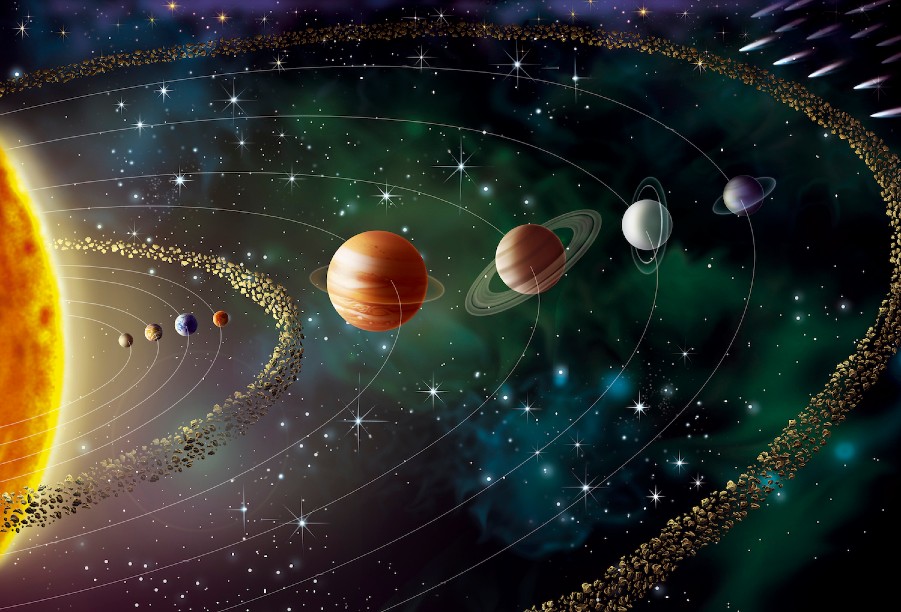
Solar System
There is unlimited place around the earth is called Universe.
Asteroids: This are the large sized rock which are unable to combine to form a planet, so it is also known as planetoids.
Comets: These are revolved around the sun, they have a long tail, this are also called as dirty snow ball because of ice & dust on them.
Meteors: Sometime when we see strike of light in the sky these are meteors. Several rocky objects revolve around earth. When they enter into the gravitational force pull of the earth, earth attracts them. When they enter the atmosphere of earth, due to friction a lot of heat is produced and they start burning this is when they appear in sky as a streak of light for some time.
Galaxy: It is the collection of billions of star, gases and dust held together due to gravitational pull. The galaxy we live in is called Milky Way.
Stars: These are the luminous bodies which possess the light of their own.
Constellation: Some stars make beautiful patterns or shapes in the sky. These shapes are called Constellations.
SUN
- It is the only star in our solar system.
- Distance of sun from earth is greater than distance of earth from moon.
- Sun is the center of solar system.
- The circle or path followed by the planets to revolve around the sun is called an orbit.
- Earth takes 365 days to revolve around the sun.
PLANETS
-
Mercury: It is the nearest planet to the sun and also smallest planet.
-
Venus: It is the closet planet to the earth.
- It is also the brightest and the hottest planet.
- It is also known as morning and evening star.
- It look in phases from earth like moon comes.
- It's atmosphere is very dense and mostly covered with carbon dioxide gas.
-
Earth: It the only planet where life is possible right now because of availability of proper oxygen, water, land and protection of ozone layer. About 71% of earth surface is covered with water.
-
Mars: It is also called red planet because it has a layer of red dust on it which is a chemical called iron oxide. This planet has very thin layer of atmosphere.
-
Jupiter: It is the biggest planet, it has the maximum gravitation force compared to other planet of solar system.it has 79 natural satellite.
-
Saturn: It possess beautiful ring around it. This ring are made up of dust, ice and rocks. It is the second largest planet. It has the most number of natural satellites.
-
Uranus: This planet has also ring but not visible.
-
Neptune: This planet is faint and not easily visible.
Terrestrial and Jovian planets
- Mercury, Venus, Earth and Mars are terrestrial planet because of similarities in structure with earth.
- Jupiter, Saturn, Uranus, and Neptune are Jovian planet because of similarities in structure with Jupiter.
- Ganymede is the largest natural satellite of our solar system and it is the moon of Jupiter.
- Titan is the satellite of Saturn and it is the second largest moon of solar system.
Worksheet
- Why Pluto is not considered as planet?
- A. It has stopped burning
- B. It's orbit is irregular
- The time taken by moon to go around the earth once is ____?
- A. 1 month
- B. 1 year
- C. 27.3 days
- D. 45 days
- A comet is different from planet because?
- A. It has its own light
- B. It's orbit is highly elliptical
- C. It does not orbit the host star.
- Changes in season is caused by___?
- A. Rotation of earth
- B. Revolution of earth
- C. Revolution of sun
- Which of the following is incorrect statement for sun?
- A. Sun is a huge mass of hot gases.
- B. Sun is the only planet we can see through naked ice.
- C. The distance of sun from earth is about 150,000,000km.
- D. Sun provides us light energy.
- The planet Uranus which statement is correct?
- A. It has no rings.
- B. It has rings but not visible to us.
- ____ is the collection of star, dust and gases?
- A. Asteroids
- B. Galaxy
- C. Planet
- The revolution period of 3 planets of solar system are given in the
following?
Which of the following conclusion made by the data?Planet Revolution days X 224 days Y 88 days Z 12 days - A. Planet Z is located nearer to the earth.
- B. Planet X is located farther from earth.
- C. Planet X will be colder than earth.
- C. Planet Y will be hotter than earth.